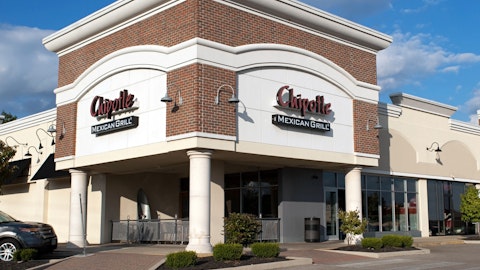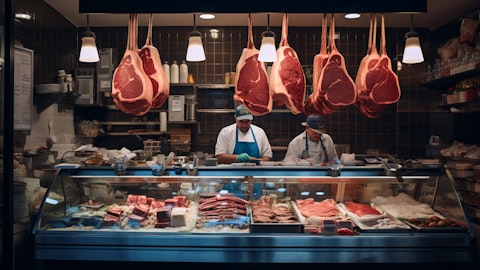We’ve had multiple years of inflation, if those ease a little bit, if labor inflation eases a little bit as well. There’s a number of ways to get there. And I would use the algorithm as more a long-term guidepost rather than something we’re going to look to be right on the money every single quarter, every single year. So I feel like our economic model is really, really healthy. We’re really knocking on a door of that 27%. And with a break here or there, I think we will hopefully get there next year.
Dennis Geiger: That’s great. Thanks for that. And then I appreciate the strong traffic number in the third quarter. Can you just provide the price and mix breakdown in the third quarter, Jack, and if you care to talk at all about how to think about those components into the fourth quarter level thinking about that mix in particular? Thank you very much.
Jack Hartung: Yes, sure. The price we were running in the quarter was in the high 2s, call it right around 2.8-ish, something like that. And remember, that’s all from pricing we took last year. We didn’t take any additional pricing until just recently. And mix did ease a little bit. Mix was more than 2% range. So you add that on top of a better than 4% transaction comp during the quarter, and that’s how you get there. Looking forward into Q4 with a 3% we just took, remember we took it in the second half of October so that will average out to about a 2.2 percentage, call it a low 2 menu price increase. We are starting or we did start to see the negative mix component ease during the quarter. And if that continues, we would expect that the mix component would be still a drag but it would be hopefully closer to a drag of 1% than the 2% that we saw in this quarter.
And of course, Brian mentioned we continue to see strong mid single digit transaction comps in the fourth quarter so far.
Dennis Geiger: Thank you.
Operator: Our next question comes from Andrew Charles with TD Cowan. Please go ahead.
Andrew Charles: Great. Thanks. Jack, a simple clarification, do you consider the recent 3% price increase to brace yourselves for AB 1228 next year? Or are you planning a separate California targeted price increase to be utilized sometime around April to help mitigate the impact of the higher California wages?
Jack Hartung: Yes. This does not consider any part of the California wages that’ll happen next year. We’ve been studying that, Andrew, as you can imagine, already. It’s going to be a pretty significant increase to our labor. Our average wages in California are right around 17%, so we get the minimum up to 20% and to make sure that we take care of compression as well. We’re going to have to increase wages in call it the high teens to 20% or so. We haven’t made a decision on exactly what level of pricing we’re going to take. But to take care of the dollar cost of that and/or the margin, part of that we haven’t decided yet where we will land with that. It’s going to be a mid to high single digit price increase, but we are definitely going to pass this on. We just haven’t made a final decision as to what level yet.
Andrew Charles: Got you. Okay, that’s helpful. And then, Brian, a question on innovation, it looks like there’s no innovation in the stage gate process as obviously you’re prioritizing operations and projects square one [ph]. I’m curious, what do you need to see to resume your new menu innovation, in particular, if it’s reaching a number of transactions per peak 15 minute or some other measure looking at to resume new menu innovation piloting?
Brian Niccol: Yes. So the teams are still working and iterating on menu innovation. One of the things that they uncovered, which I’m really excited about, is we have an opportunity to just talk about our core menu. So there’s very little awareness and understanding of what [indiscernible] are. And you’ll probably be seeing our team’s doing some work on how do we bring to life what we currently have on our menu so that customers can understand and truly enjoy everything that we currently offer? At the same token, they’re still doing some work on what are some new menu items. And we’re also doing work on bringing back some menu innovation that we’ve done in the past that has really rung the bell. So I’m feeling really good about where our menu stands and the pipeline that we have for news over the next, call it, 18 to 24 months.
Andrew Charles: Awesome. Looking forward to it. Thank you.
Operator: Our next question comes from David Palmer with Evercore ISI. Please go ahead.
David Palmer: Thanks. A question on labor productivity. I’m wondering how you’re thinking about the drivers on getting back to something like you’ve done in the past, that 23% or so labor margin, what are the key unlocks from here? You’re obviously finding some traction on just paying attention to how you deploy labor and some of the things you’re doing even with computer vision and whatnot. But then there’s the other side, which might be the bigger leap stuff with equipment. So I’m wondering how you’re thinking about the timing of these things, and how I’m really obviously thinking about 2024 and what drivers you see there?
Jack Hartung: Yes. David, I don’t know that we’ll see 23% at least not in the near future. We’ve taken on some significant labor inflation over the last few years. And this California Act that we just talked about, California is only 15% of our restaurants. But that’s all by itself. Next year, that’s going to add 2.5% to 3% inflation to our overall company, inflation in labor. So I don’t know that we’ll see 23%. But the essence of your question is, what are we going to do to continue to be efficient with labor? And I think you hit on all the key pieces. For what we have in our restaurants today, we’re really efficient. It doesn’t mean we don’t have some opportunity, but our teams are doing a great job. And for the most part, they’re using the labor that they need to throughout the day.
I think the unlock is that we have the labor deployed properly. Brian mentioned this during his prepared comments so that we have the right people that are staying on the frontline, so we could drive better throughput. When we drive better throughput, we know with a 40% flow through and we know with our ability to lever labor that that labor percent will go down. And then over the I’ll call it the medium term and long term with things like Autocado and with Hyphen, I think there’s opportunities for us to try to offset some of the labor inflation. But I just don’t know that we would be able to get all the way down to 23%. That would be an 8% deflation. And that’d be I think difficult to accomplish. But rest assured that there’s a lot of things that as we’re working on investments that can make not just reduced hours, but also make the jobs of our crew easier, better and free them up so they can provide better customer service, we’re definitely going to invest in that.
David Palmer: Yes. If it makes you feel any better, I don’t think anybody has 23% in their models or anything, but —
Jack Hartung: Okay. Just wanted to make sure.
David Palmer: When you mentioned the four to five entrees in that peak 15 minute window improvement, what is the benefit to same-store traffic and/or just labor productivity you’re getting from that? Can you put that into perspective?
Jack Hartung: Yes. In terms of like comps, for example, we need about five transactions in a day to get a 1% comp. And so if you get three, four additional transactions in a 15 minute period, do that for multiple periods, you can easily add up the math and you can get 2%, 3% additional comp in all those restaurants that are seeing that additional flow through. In terms of leverage, David, I’d have to go through the math. Generally, as you add two, three additional transactions, you’re going to see tens of basis points, you’re not going to see 100 basis points or anything like that, you’re going to see tens of basis points of leverage on the labor line. So it’s certainly nice, but it’s not — again, it’s not going to get you down to anything in the sub 24% range.
But keep in mind, the important thing from our margin standpoint, every single additional transaction we bring in, there is a 40% pass through down to the cash flow line. And that’s how we want to grow our margins.
David Palmer: Thank you.
Operator: Our next question comes from Lauren Silberman with Deutsche Bank. Please go ahead.




